Types Of Sewing Machines Explained: Which Is Best For You?
Sewing machines are wonderful tools! People use them to make all sorts of things, like clothes, cool decorations for their homes, fun crafts, and even for fixing things. When you know the different kinds of sewing machines, you can pick the perfect one for what you want to do. The right machine makes sewing easier, quicker, and more enjoyable.
This article will simply explain the common sewing machine types, helping you understand them better. This guide helps you understand sewing machines, whether you are sewing for fun, fixing things, or even adding professional touches like brand labels to your items. Our goal is to help you learn more about sewing machines so you can choose one that’s right for your needs.
1. The main types of sewing machines explained
Here, we’ll look at the most common types of sewing machines you might find. Each one has its own special features.
1.1 Mechanical sewing machines
Mechanical sewing machines are like the classic, sturdy type. You use knobs and dials to choose stitches and settings. They don’t have computer parts.
Key features:
- Basic stitches: They usually sew a straight stitch (good for joining fabric) and a zigzag stitch (good for finishing edges or sewing stretchy fabric).
- Stitch adjustment: You can change how long or wide the stitches are by turning a dial.
- Durability: Many are built with strong metal parts inside, so they can last a very long time.
- Manual tension: You adjust the thread tension (how tight the thread is) yourself with a dial.
Pros (good things):
- Often cost less.
- Simple to learn and use.
- Strong and reliable.
- Good for learning how sewing works.
- Maintenance like oiling can be easier.
Cons (not-so-good things):
- Fewer types of stitches.
- No automatic features like making buttonholes (or only very basic ones).
- You have to set everything by hand.
Best for:
People who are new to sewing. Fixing clothes or simple home items. Craft projects. If you only need to sew sometimes. Their straight stitch is strong, which is important for all sewing. You could even attach a simple woven label (a label made by weaving threads together, like on clothing necklines) with a straight stitch, if you need a basic, sturdy attachment. Many sewers find these great for learning because you directly control every setting.
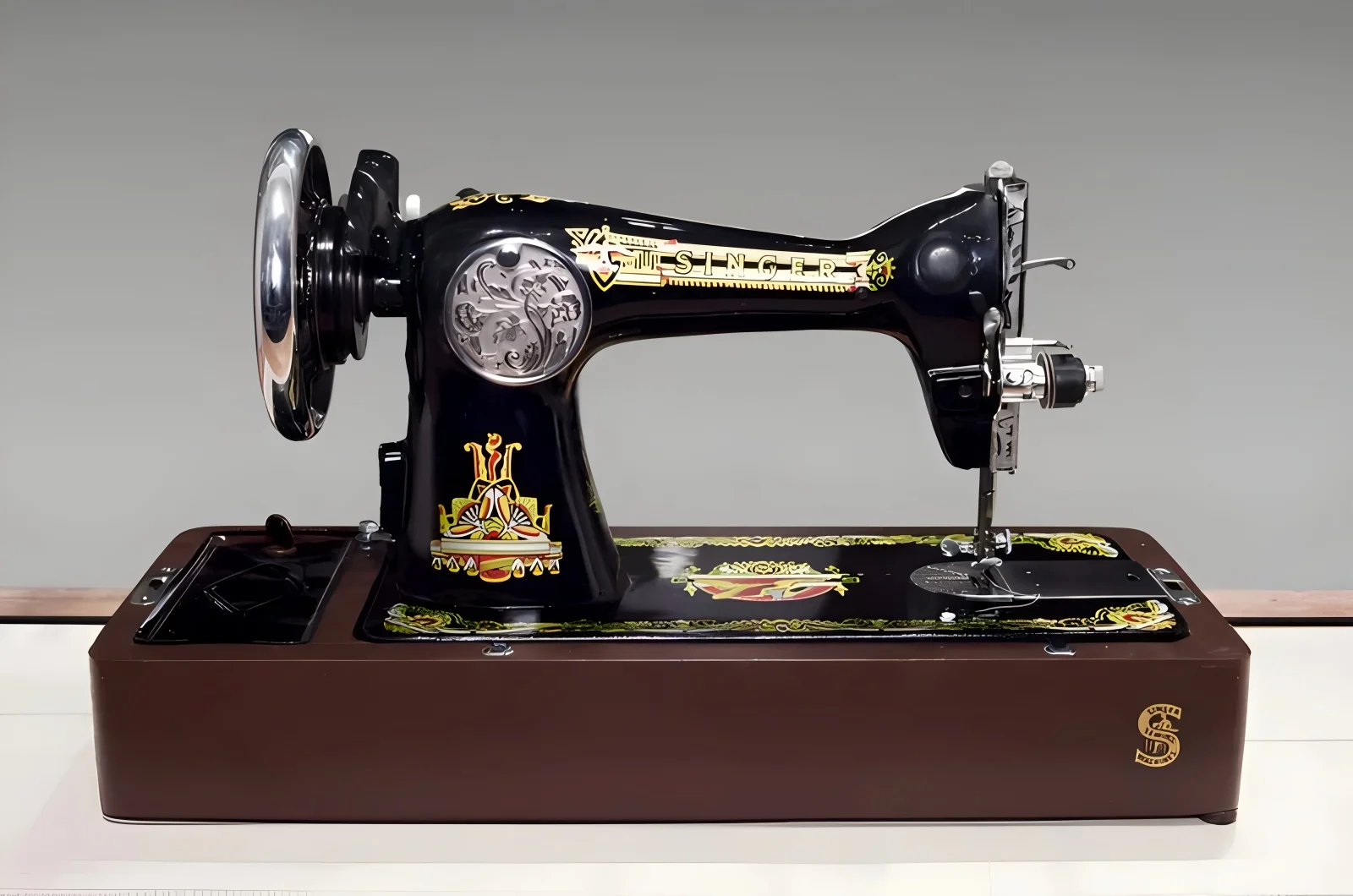
1.2 Electronic sewing machines
Electronic sewing machines are a step up from mechanical ones. They use electricity for more power and features. They often have buttons to pick stitches and a small screen (called an LCD screen) that shows your choice.
Key features:
- More stitches: Besides basic stitches, they might have pretty decorative stitches, special stitches for stretchy fabrics, and automatic buttonholes (you put your button in a special foot, and the machine sews the right size buttonhole).
- Needle up/down button: This button lets you choose if the needle stops in the fabric (helpful for turning corners) or out of it.
- Speed control slider: You can set a top sewing speed. This is good for beginners or when sewing tricky parts.
- Push-button stitches: Easier to choose stitches with buttons instead of dials.
Pros (good things):
- Choosing stitches is easier.
- More built-in features can make some sewing tasks simpler.
- Often a good mix of features and price for many sewers.
Cons (not-so-good things):
- Can cost more than mechanical machines.
- If an electronic part breaks, repairs might be more expensive.
Best for:
People who sew for a hobby regularly. Making clothes. Home items like curtains or pillows. The better control over stitches can be helpful when you need to sew neatly, for example, when attaching sew-on patches (patches designed to be stitched onto fabric).
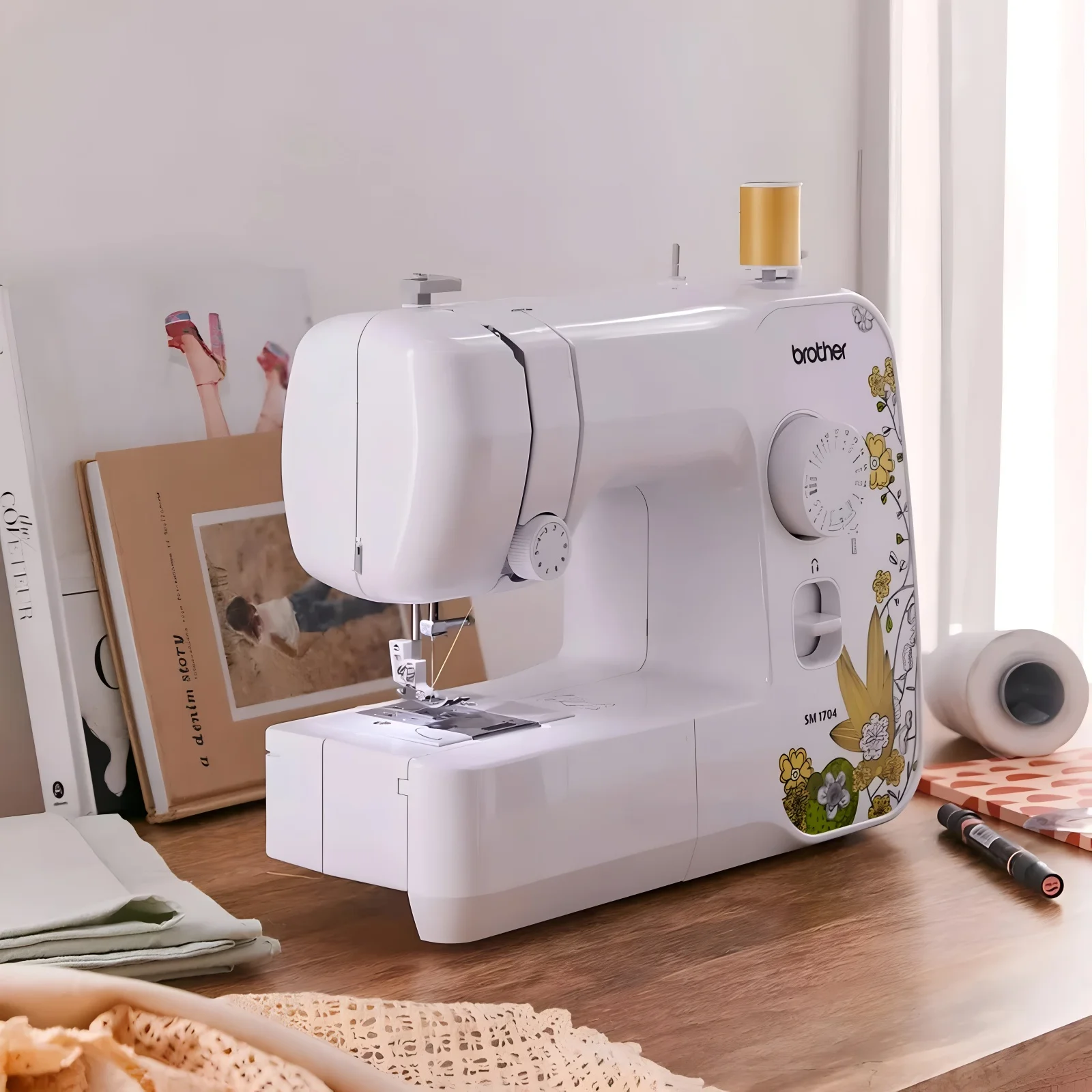
1.3 Computerized sewing machines
Computerized sewing machines are the most advanced type for home sewing. They have a small computer inside. They often have large touch screens, many automatic features, and sometimes a USB port to bring in new designs or update the machine’s software.
Key features:
- Hundreds of stitches: Many pretty decorative stitches, alphabet letters for writing names (monogramming), and special stitches for quilting.
- Programmable stitches: You can combine stitches to make your own unique patterns. (Tell the machine to sew one stitch, then another, then another, in an order you choose.)
- Automatic thread cutter: Cuts the top and bottom threads for you with a push of a button.
- Advanced needle threader: Many have an easy way to thread the needle automatically.
- Memory: Can remember your favorite stitch settings or combinations.
- On-screen help: Some machines show on the screen which sewing foot (the part that holds fabric down while sewing) to use for a chosen stitch.
Pros (good things):
- Can do many, many different things.
- Stitches are usually very exact and neat.
- Many automatic features save time and make sewing easier.
- Great for very creative and complex projects.
Cons (not-so-good things):
- Are the most expensive type.
- Can be tricky to learn all the different features.
- Repairs can cost a lot if the computer parts break.
Best for:
People who sew very seriously. Quilters. People who love embroidery (some machines do both sewing and embroidery). Those who want the most creative options and help from the machine. Some computerized machines can make programmable stitch patterns for unique label borders, which is great if you want a very custom look for your brand labels.

1.4 Embroidery machines
Embroidery machines are special machines that sew designs, pictures, and letters onto fabric using thread. They make the fabric look decorated.
- Standalone: A standalone embroidery machine only does embroidery. You would need a different machine for regular sewing.
- Combo: A combo embroidery machine can do both regular sewing and embroidery. It’s often a computerized sewing machine that has an extra part (embroidery unit) you attach for embroidery.
Key features:
- Embroidery hoops: These are frames that hold the fabric very tight while the machine stitches the design.
- Built-in designs: They come with some designs and letter styles already in the machine.
- Import designs: You can often add more designs from a USB stick or by connecting to a computer. You might need special computer software to make or change designs.
- LCD touch screen: Usually have a screen to pick designs and make small changes.
Pros (good things):
- Makes beautiful, professional-looking custom embroidery.
- Great for making gifts, clothes, and home items special and unique.
Cons (not-so-good things):
- Can be expensive.
- Learning embroidery takes practice (like how to use stabilizers, which are special backings for fabric, and how to hoop fabric correctly).
- Standalone machines only do one job.
Best for:
People who want to make items very personal. Crafters who have a small business and want to add logos or designs. Those who really love decorative sewing. While not mainly for attaching usual labels, embroidery machines can sew brand names or logos right onto items. This is like making a very fancy sew-on patch that is part of the fabric.
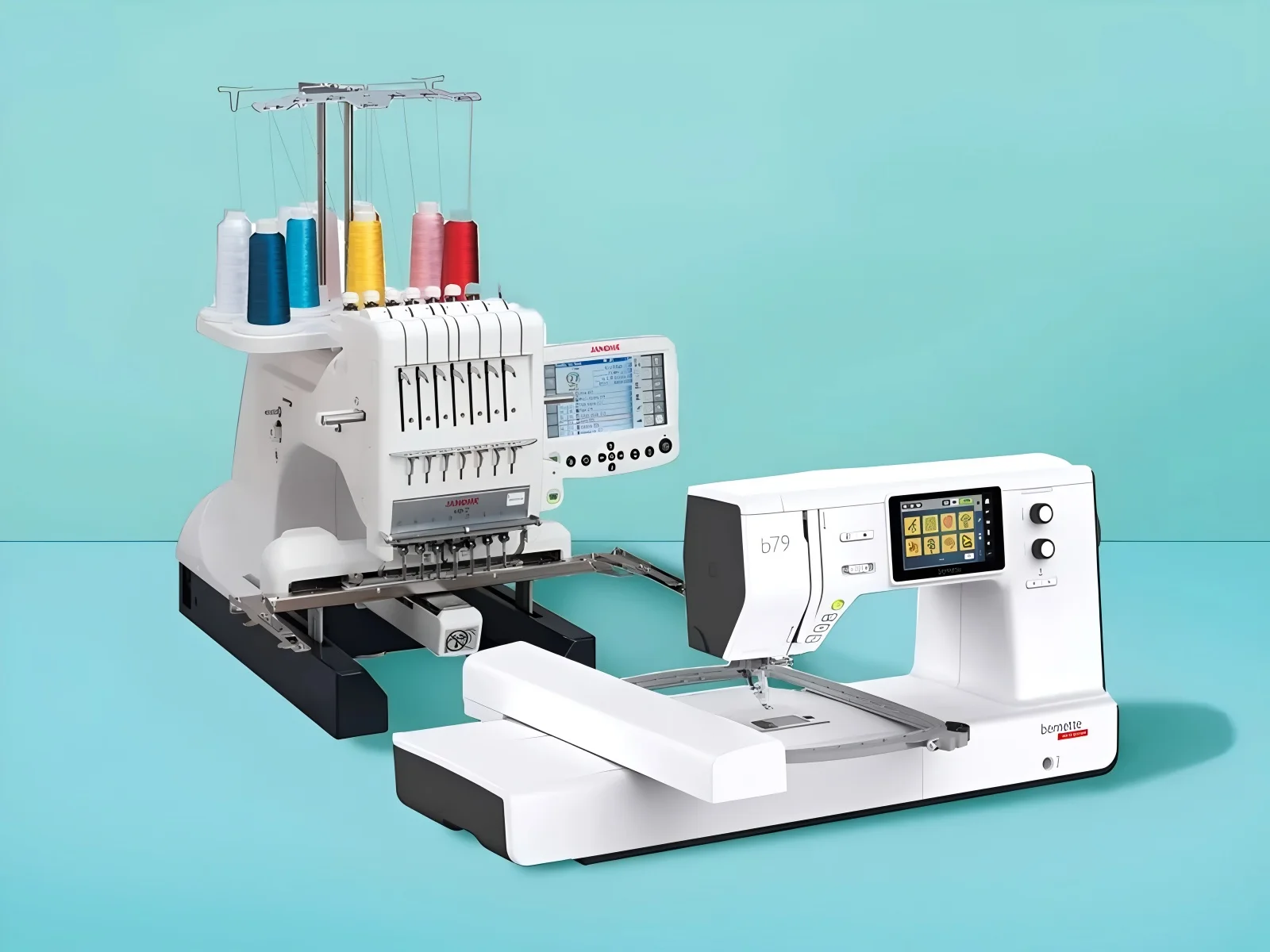
1.5 Sergers
Sergers, also called overlock machines, are special machines. They usually use 3 or 4 threads (sometimes more) to make professional seams, finish fabric edges, and cut off extra fabric all at the same time. They are different from regular sewing machines and don’t replace them.
Key features:
- Professional edge finish: Stops fabric edges from unraveling or fraying.
- Fast seams for knits: The stitches they make can stretch. This is perfect for stretchy fabrics like t-shirt material or leggings (knit fabrics).
- Differential feed: This feature helps stop stretchy fabrics from getting wavy or bunched up. It can also be used to make fabric gather or ruffle. (It has two sets of feed dogs (the teeth under the needle that move fabric) that can move fabric at different speeds.)
- Cutting blades: They have small knives that trim the edge of the fabric perfectly as it sews.
Pros (good things):
- Makes very strong, neat-looking seams and edges quickly.
- Excellent for knit fabrics and anything stretchy.
- Gives clothes a store-bought look inside.
Cons (not-so-good things):
- Cannot do things like buttonholes, zippers, or regular straight stitches in the middle of fabric.
- Threading them can look a bit scary at first because of all the threads (but new ones often have color guides to help).
Best for:
People who sew a lot of clothes, especially with knit fabrics. Those who want very neat and durable inside finishes on their sewing projects. Making activewear, baby clothes, or t-shirts. Sergers are great for finishing the edges of woven labels before you sew them onto a garment with your regular sewing machine.
This stops the label edges from fraying and gives a very clean look. This makes them a useful piece of garment finishing equipment. Many sewers find that once they learn how to thread it, a serger becomes a tool they can’t live without for professional results.
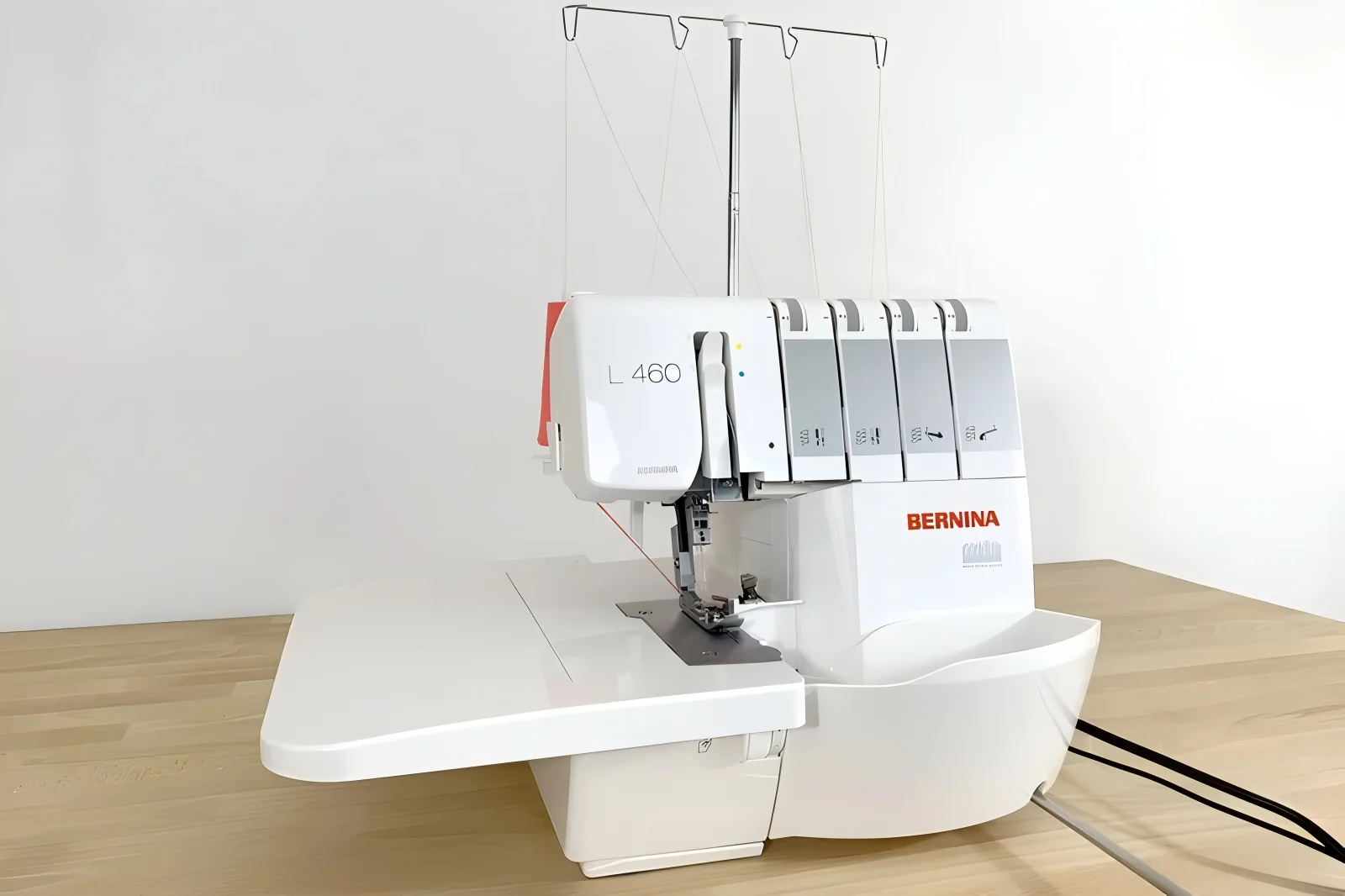
1.6 Heavy-duty sewing machines
Heavy-duty sewing machines are built tougher than standard home machines. They have stronger motors and often more metal parts in their body and the parts that do the sewing.
Key features:
- Sews thick fabrics: Can sew through thick fabrics like denim (jeans fabric), canvas (strong cotton fabric for bags), thin leather, and many layers of fabric without the motor struggling.
- Faster sewing (often): Many can sew faster than regular machines.
- Stronger needle power: The needle can push through tough materials more easily.
- Focus on power: Often, they are simpler, focusing on being strong and lasting long, rather than having lots of fancy stitches (though some electronic heavy-duty machines do have more stitches).
Pros (good things):
- Very strong and lasts a long time.
- Good for projects that would be too hard for a regular machine.
- Can sew faster.
Cons (not-so-good things):
- Can be heavier to carry around.
- Might be too powerful for very thin, delicate fabrics (it could damage them).
- Some basic heavy-duty models might have fewer pretty stitch options.
Best for:
People sewing tough materials like bags, jeans, outdoor gear (like backpacks), or fixing furniture covers (upholstery). Those who sew very often and need a machine that can work hard. Their strength makes them ideal for sewing specific materials, such as the thick fabrics and durable labels often found on denim or canvas items.
Heavy-duty sewing machines for denim and canvas tags are popular because these materials need more sewing power. If you need to attach thick labels or patches to sturdy items, a heavy-duty machine is a good choice.
For sewing many, many items, some businesses use an industrial sewing machine (a very powerful machine built for all-day factory use). But for many small businesses or serious crafters, a home heavy-duty sewing machine is excellent for attaching thick labels or sewing on tough materials.

1.7 Coverstitch machines
A coverstitch machine is another special machine, a bit like a serger, but it does a different job. It creates professional hems (the bottom edge of sleeves or shirts), especially on knit hems. It makes two or three straight lines of stitching on the top and a loopy stitch on the back. You often see this kind of hem on t-shirts and activewear.
They are great for hemming t-shirts, sportswear, swimwear, and any stretchy knit clothing. Some can also be used for decorative stitching.
Important: it does not cut fabric like a serger does. It’s a specialized piece of garment finishing equipment.
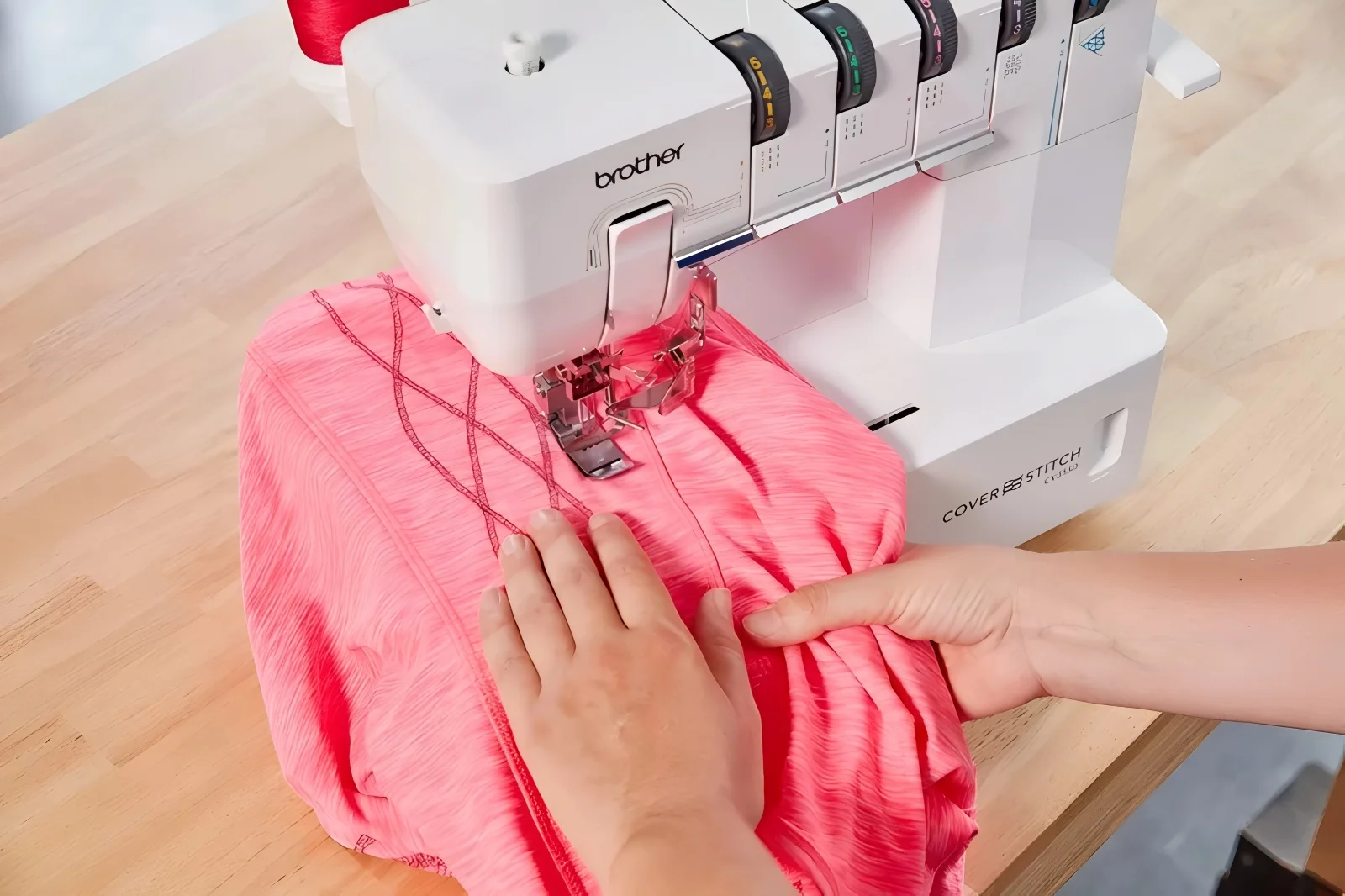
If you make items to sell, or even as special gifts, a neatly sewn label makes your product look much more professional. It’s a key part of your branding. The right sewing machine can help you attach labels well and easily.
Choosing the right sewing machine is a key step in professionally applying your brand’s woven labels and tags. This tool is essential for quality branding and textile customization.
2.1 Key machine features for label attachment
Good stitch options:
- Straight stitch: This is the most common and usually the best stitch type (e.g., straight stitch) for labels. It looks clean and holds the label securely. A straight stitch machine will excel here.
- Zigzag stitch: Sometimes used for sewing around the edges of patches, but for most flat labels, a straight stitch is better.
- You need types of sewing machine stitches for durable label attachment, and a good, even straight stitch is usually the most durable and neatest.
The right needle & thread:
- Make sure your needle for specific fabrics matches your fabric and your label. For example, use a sharp needle for woven fabrics and woven labels, and a ballpoint needle for knit (stretchy) fabrics.
- Good quality thread is important so the label stays on. Choosing the right thread for label attachment is key; polyester thread is often a good choice for many labels.
Helpful presser feet: (a presser foot is the part that holds the fabric down as you sew.)
- Your regular all-purpose foot often works fine.
- A zipper foot or an edge stitch foot can be very helpful. They let you sew very close to the edge of the label, which looks neat. You might even find a specific accessory, like a label presser foot, designed for this task.
- Some people like a clear foot (see-through foot) so they can easily see where they are sewing on the label.
Good machine control:
- The machine should feed the fabric smoothly for even stitch consistency.
- Being able to sew slowly and carefully is important for getting labels straight.
2.2 Which machine types work well for labels?
- Basic mechanical or electronic machines: These are often perfectly fine for attaching labels, especially if you are making things on a small scale or for a hobby. If your current machine sews a good straight stitch, it will likely work for labels. A portable sewing machine for small business applying fabric labels can be one of these types.
- Heavy-duty machines: These are best if you are sewing thick labels (like some canvas or rubber labels that can be sewn) or if you are attaching labels to very tough fabrics like denim or heavy canvas bags. These are good sewing machine for labels and can act as a tag attachment machine. For items made of denim, heavy-duty sewing machines for denim and canvas tags are a solid choice.
- Lockstitch machines (industrial vs. heavy-duty home): A lockstitch is the most common type of stitch that home sewing machines make, using a top thread and a bottom thread (from the bobbin) that lock together in the fabric; your home machine likely makes a lockstitch (machine type: lockstitch machine). For very large businesses that sew thousands of labels, they might use an industrial sewing machine. These are very fast and built for constant use. The best industrial sewing machine for bulk sewing tags is a significant investment. However, for most small businesses or crafters, a good home machine (especially a heavy-duty one if needed) is usually enough for sewing machines for label application.
At Packlove, we work with countless brands and see it time and again: a neatly sewn label instantly elevates a product’s perceived quality. Your choice of sewing machine directly impacts the final look and durability of your branding.
2.3 Tips for sewing different labels
- Woven labels: It’s often best to fold the short edges of the woven label under before sewing (this is called an end fold or center fold, depending on the label style). This gives a very neat, finished look and hides raw edges. Sew close to the edge of the label. Using a sewing machine is a common attachment method for woven labels.
- Sew-on patches: These are usually sewn with a straight stitch all around the edge. Sometimes a zigzag stitch or a tight satin stitch can be used to create a bolder border, if your machine does this well.
- Edge stitching: Sewing right along the very edge of the label is called sewing technique: edge stitching labels. This is a key skill for attaching many types of labels neatly.
- Placement: Think about the best practices for placing and sewing brand tags. Try to put them in the same place on all your items for a professional look. Always secure your stitches at the beginning and end by backstitching a little.
Sewing labels gives a strong, classic attachment. For some labels or fabrics, people use heat transfer label (a label applied to fabric using heat and pressure, often tagless) options. But this guide is about sewing.
Many garment makers use sewing machines to attach brand tags. Durable labels require correct sewing machine stitch. Indeed, choosing sewing machine impacts label application quality, and a sewing machine is a tool for enhancing product branding.
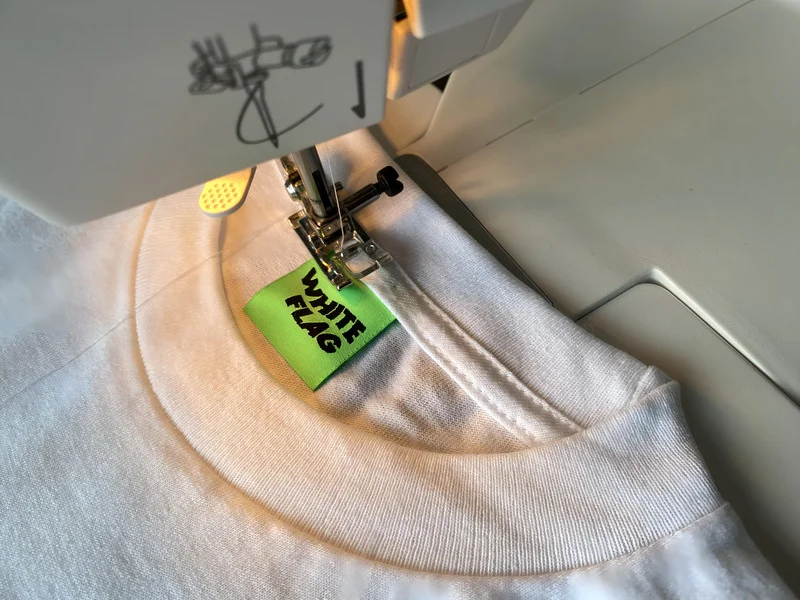
3. Key factors to consider when choosing any sewing machine
Thinking about these points will help you in choosing a sewing machine.
Your sewing goals & projects:
- Think about: What do you mostly want to sew? (Examples: clothes for yourself, quilts, simple fixes for clothes, bags, soft toys for kids).
- Knowing this helps you decide if you need many different sewing machine features, a strong machine for thick fabrics, or special features like for embroidery.
Your skill level (how much you already know about sewing):
- Beginner: If you are just starting, look for a machine that is easy to use, has the basic stitches (straight and zigzag), and comes with clear instructions. A mechanical or a simple electronic machine is often a good beginner sewing machine.
- Intermediate: If you have some experience, you might want more stitch choices, better ways to make buttonholes, or features like a needle up/down button. A good electronic machine or a simpler computerized one could be right.
- Advanced: If you sew a lot and love trying new things, you might want a machine with many features, the ability to program stitches, or special functions for quilting or embroidery. Look at computerized machines, embroidery machines, or sergers.
Your budget:
- How much do you want to spend on a machine? Your sewing machine budget matters. Sewing machines can cost from less than $100 to many thousands of dollars.
- Decide on a price range that works for you. Remember to also think about buying accessories like extra needles, thread, and different presser feet.
Features you need vs. features you want:
- Make a list. What features must the machine have? (Example: a good, reliable straight stitch, a way to make buttonholes if you sew clothes).
- Then think about features that would be nice to have but aren’t essential (Example: an automatic thread cutter, hundreds of pretty stitches).
- Try not to pay a lot for fancy features if you don’t think you will use them often.
Machine durability & build quality:
- Read reviews from other people about how long their machines have lasted. A machine with a metal frame inside is often stronger and more durable.
- Good build quality helps with stitch consistency.
Space & portability:
- Do you have a special table or room for sewing? Or will you need to put the machine away after you use it?
- Think about how heavy and big the machine is if you need to move it often.
Ease of use and maintenance:
- Look for information about how easy the machine is to set up and start sewing with.
- How easy is it to clean and oil the machine?
4. Frequently asked questions
4.1 What’s the best type of sewing machine for a complete beginner?
For someone completely new to sewing, a good quality mechanical sewing machine or a basic electronic sewing machine is usually best. They are simpler to use, have the main stitches you need, and help you learn how sewing works without too many confusing buttons or features. Look for one that has clear instructions.
4.2 Do I need a serger if I have a regular sewing machine?
You don’t need a serger to sew. But, a serger is wonderful for making seams look very professional, especially on stretchy knit fabrics (like t-shirts). It also finishes fabric edges neatly so they don’t fray.
A serger helps a regular sewing machine; it doesn’t replace it. Consider the serger vs sewing machine benefits. Think about getting one if you plan to sew a lot of clothes and want them to look store-bought inside.
4.3 What’s the difference between an electronic and a computerized machine?
Electronic machines use buttons (often with a small screen) to choose stitches and usually have more features than mechanical ones (like more stitch types or an automatic buttonhole). Computerized machines have a computer inside, often a touch screen, and can offer hundreds of stitches, remember your settings, and do advanced things like cut threads automatically.
When comparing electronic vs computerized sewing machine options, computerized machines can do more but usually cost more and can be more complex to learn.
4.4 How many stitches do I really need?
For most sewing, you mainly need a good straight stitch (for seams) and a zigzag stitch (for finishing edges or sewing stretch fabrics). A way to make buttonholes is also very useful if you sew clothes. Maybe a blind hem stitch. Many machines offer lots of pretty decorative stitches, which are fun, but not essential for basic sewing. Don’t pick a machine just because it has how many stitches if you won’t use most of them.
4.5 Can I use a regular sewing machine to attach labels?
Yes, definitely! Most standard sewing machines – whether mechanical, electronic, or computerized – can attach labels very well using a straight stitch. The important things are to use the right kind of needle and thread for your garment fabric and your label material, and to sew slowly and carefully.
If you are sewing very thick labels or onto very tough fabrics, a heavy-duty sewing machine for labels might work better. This helps you understand if an existing sewing machine is suitable for brand label application.
Explore more:
We hope this guide has clarified the world of sewing machines for you. Understanding the different types and their features is the first step toward choosing the perfect machine for your projects—whether you’re hemming a pair of pants or building a brand with professionally attached labels. Whatever your goal, we wish you success and joy in your sewing journey. Happy sewing!






















